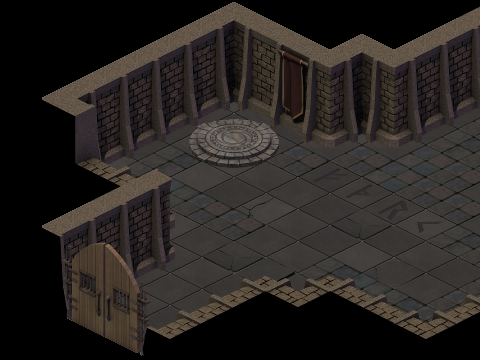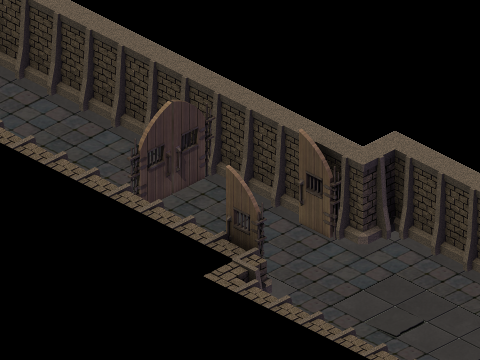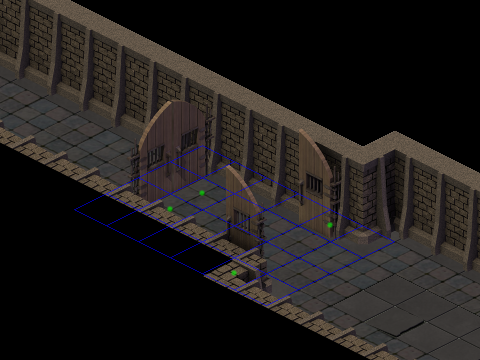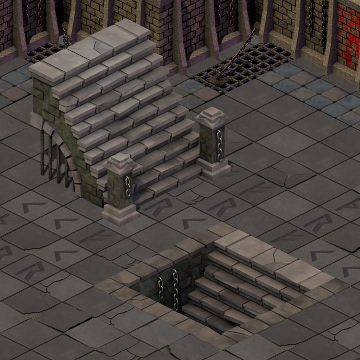Bastion
This weekend I was tempted to run out and purchase Guild Wars 2, but decided to stay in and give some love to my Steam library instead. In particular, I finally took the time to play through most of, and finish, Bastion. I realize I’m late to this party, but I’m going to gush on it anyway.
Art
The goddamn art. Jen Zee’s work is incredible. This is one of the few times in my entire life that I’m sad to be partially colorblind — if the game is already lush and beautiful as I perceive, I can’t even fathom what it really looks like. Action RPGs definitely don’t need to be dark/gothic to be compelling.
There were about three moments during my playthrough where I fell off an edge because it looked like solid ground, but was actually some taller object further away. For the most part they did a good job of making the active areas brighter than the inactive places. I found myself having to pay attention in some twisty areas to determine what was floor.
I like the art tricks used with The Kid. Because he generally always looks the same (same face/hair, same clothes) most of the animations had to only be pre-rendered once. Notice how the weapons are stowed away for many of the animations — there’s no real need to render every weapon for every animation. This makes logistics far easier, and it’s less painful to introduce new animations. They can introduce one “falling asleep” animation which doesn’t need to include every face/race/gender/weapon/armor combination. If you’re out there dreaming of creating a 2D RPG, seriously consider having a fixed main character and what that can do for your art workload.
Story
The Narrator does a superb job of telling the story of Bastion. His voice, and the character, absolutely oozes with style. Importantly, he informs the player of the story without interrupting the action. Normally direct exposition is a bad idea in games (and movies, etc) but the way it’s handled here has great charm. The Narrator is also used efficiently to remind the player of game mechanics — at one point he reminded me that I wasn’t using my special skills. In a single playthrough I didn’t find the voice repetitive, which was a great surprise.
While the Narrator spells out the details of the story, the overall story is told in every scrap of art and every note of the soundtrack. I love the Mementos in the game — mostly random items that have a little story attached. I’ve had plans for a while to use memento items as collectables in Wandercall. Games like Dark Souls put even more emphasis on item lore, with nearly every individual item forming a puzzle piece to the entire world.
In the most emotional scene in the game, the player still has some control. I have a lot of respect for this, instead of e.g. putting the player in a cutscene. I believe mechanics like this are one reason why games have greater potential for emotional impact to the audience than most other storytelling media.
The player doesn’t actually need to know any of the story to get through the game. That’s a trend in many successful action RPGs, at least ones that I’ve enjoyed. Not to say that deep dialog or developing relationships can’t be in RPGs (they absolutely shine there), but on the action end of the spectrum we can have great games that keep it simple.
Gameplay
The combat itself is pretty fun. At first I worried that it felt a bit too slow or sluggish, but that’s mostly alleviated by the roll maneuver. And combat definitely didn’t feel slow, especially during the dream/memory sequences.
I enjoy that each creature is weird (not an orc in sight) and serves a unique gameplay role. Well, for the most part — each creature seems to have several subtypes that change up the way they attack. Sometimes I wasn’t quite sure which version I was dealing with until their first attack, but I think that’s completely acceptable (it’s quite true for my game). I really like the enemy health meter display; it blends so well that I actually didn’t notice it until halfway through the game.
I love several mechanics of the combat; some seem to be quite popular in action RPGs. Systems that have an active block button also tend to reward the player for a Just-In-Time block. In Bastion it damages the attacker (even on ranged attacks!!). In Dark Souls it’s a parry/riposte mechanic. I really should look into adding just-in-time blocking to Flare.
I love how the game mixes melee and ranged combat well. Even several of the melee weapons could be used in ranged attacks. There were several mechanisms to balance the effectiveness of ranged weapons, particularly timers to aim and reload. The “perfect shot” mechanic is another example of great gameplay — using time to add depth to maneuvers, rather than adding more buttons.
I’m impressed that so much of the game options were done through the town. The game doesn’t need an Inventory button because there’s a building where you can switch out equipment. Same with passive bonuses and weapon upgrades. Impressively, they even managed to create Achievements and Difficulty as in-game locations. These are gradually revealed to the player (starting players aren’t overwhelmed with options), and it’s expertly integrated with the story (the hero is fighting against a cataclysm by rebuilding a tiny town).
The game gets by without a quest system. There’s the overarching “gather X MacGuffins” theme, but the player never really has to choose which objective to complete next. I always had 1 or 2 next maps to explore if I wanted some action, or I could fiddle with options in town, or practice weapons at one of the weapon challenge maps. The Narrator adds some purpose and context to the story maps once you arrive, but mostly that’s just flavor. I find this interesting. It doesn’t seem like a player can really get “stuck” or forget what to do next. There’s always just the next dreamlike area to explore.
Impressions
I admire the game quite a bit, and I plan to return to try NewGame+ at some point. After hearing other people talk about the game, I’m a bit surprised at how light the story is. The game had a strong impact on me, but it didn’t require a ton of story details to get there. I’m also surprised at how long the game was, in that it’s longer than I expected. I put the game down a while back, hoping to savor and stretch out the experience — but turns out I was only about 10% through the main story. I want to take Bastion as a challenge, and make Flare and (especially) Wandercall better games for it.





